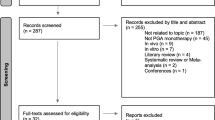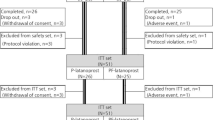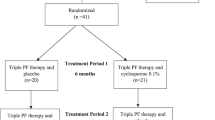Abstract
Introduction
Preservatives in ophthalmic preparations are known to cause ocular surface damage. Excipients can also contribute to oxidative stress in the compromised ocular surface. We evaluated commonly used topical glaucoma medications to ascertain pH levels and the intrinsic presence of free radicals.
Methods
Samples of 27 topical glaucoma preparations were analysed for total free radical presence using a Randox Kit for total antioxidant status. Analytical grade indicator paper was used to ascertain pH levels.
Results
Free radical concentrations for these 27 glaucoma preparations ranged from 0 to 4.54 mmol/l, with a median value of 0.66 mmol/l (mean value of 0.662 mmol/l, SD 0.839). Levels of pH ranged from 4.0 to 7.4, with a median value of 6.5 (mean 6.252, SD 0.826). There was no evidence of a direct correlation between these two variables (r=0.232, P=0.275).
Conclusion
This study is the first to document the range of pH and concentrations of free radicals intrinsically present in commonly used glaucoma medications. Long-term exposure to preservatives, free radicals, and pH levels could all contribute to ocular surface damage. The effect of excipients could be responsible for patient intolerance when changing products in the compromised ocular surface.
Similar content being viewed by others
Log in or create a free account to read this content
Gain free access to this article, as well as selected content from this journal and more on nature.com
or
References
Kass MA, Heuer DK, Higginbotham EJ, Johnson CA, Keltner JL, Miller JP et al. The Ocular Hypertension Treatment Study: a randomized trial determines that topical ocular hypotensive medication delays or prevents the onset of primary open-angle glaucoma. Arch Ophthalmol 2002; 120 (6): 701–713; discussion 829–830.
Baudouin C, Labbé A, Liang H, Pauly A, Brignole-Baudouin F . Preservatives in eyedrops: the good, the bad and the ugly. Prog Retin Eye Res 2010; 29 (4): 312–334.
Pisella PJ, Pouliquen P, Baudouin C . Prevalence of ocular symptoms and signs with preserved and preservative free glaucoma medication. Br J Ophthalmol 2002; 86 (4): 418–423.
Ayaki M, Yaguchi S, Iwasawa A, Koide R . Cytotoxicity of ophthalmic solutions with and without preservatives to human corneal endothelial cells, epithelial cells and conjunctival epithelial cells. Clin Experiment Ophthalmol 2008; 36 (6): 553–559.
De Saint Jean M, Debbasch C, Brignole F, Rat P, Warnet JM, Baudouin C . Toxicity of preserved and unpreserved antiglaucoma topical drugs in an in vitro model of conjunctival cells. Curr Eye Res 2000; 20 (2): 85–94.
Leung EW, Medeiros FA, Weinreb RN . Prevalence of ocular surface disease in glaucoma patients. J Glaucoma 2008; 17 (5): 350–355.
Fechtner RD, Godfrey DG, Budenz D, Stewart JA, Stewart WC, Jasek MC . Prevalence of ocular surface complaints in patients with glaucoma using topical intraocular pressure-lowering medications. Cornea 2010; 29 (6): 618–621.
Lockington D, Macdonald E, Gregory M, Stewart P, Caslake M, Ramaesh K . Presence of free radicals in commonly used ophthalmic preparations. Br J Ophthalmol 2010; 94 (4): 525–526.
Lockington D, Macdonald EC, Young D, Stewart P, Caslake M, Ramaesh K . Presence of free radicals in intracameral agents commonly used during cataract surgery. Br J Ophthalmol 2010; 94 (12): 1674–1677.
Joyce NC, Zhu CC, Harris DL . Relationship among oxidative stress, DNA damage, and proliferative capacity in human corneal endothelium. Invest Ophthalmol Vis Sci 2009; 50 (5): 2116–2122.
Kuizenga A, van Haeringen NJ, Kijlstra A . Inhibition of hydroxyl radical formation by human tears. Invest Ophthalmol Vis Sci 1987; 28 (2): 305–313.
Buddi R, Lin B, Atilano SR, Zorapapel NC, Kenney MC, Brown DJ . Evidence of oxidative stress in human corneal diseases. J Histochem Cytochem 2002; 50 (3): 341–351.
Broadway DC, Grierson I, O’Brien C, Hitchings RA . Adverse effects of topical antiglaucoma medication. II. The outcome of filtration surgery. Arch Ophthalmol 1994; 112 (11): 1446–1454.
Baudouin C, Riancho L, Warnet JM, Brignole F . In vitro studies of antiglaucomatous prostaglandin analogues: travoprost with and without benzalkonium chloride and preserved latanoprost. Invest Ophthalmol Vis Sci 2007; 48 (9): 4123–4128.
De Saint Jean M, Brignole F, Bringuier AF, Bauchet A, Feldmann G, Baudouin C . Effects of benzalkonium chloride on growth and survival of Chang conjunctival cells. Invest Ophthalmol Vis Sci 1999; 40 (3): 619–630.
Liang H, Pauly A, Riancho L, Baudouin C, Brignole-Baudouin F . Toxicological evaluation of preservative-containing and preservative-free topical prostaglandin analogues on a three-dimensional-reconstituted corneal epithelium system. Br J Ophthalmol 2011; 95 (6): 869–875.
Kawase K, Lin W, Aoyama Y, Yamamoto T, Shimazawa M, Hara H . Effects of timolol-related ophthalmic solutions on cultured human conjunctival cells. Jpn J Ophthalmol 2010; 54 (6): 615–621.
Ayaki M, Iwasawa A, Yaguchi S, Koide R . Preserved and unpreserved 12 anti-allergic ophthalmic solutions and ocular surface toxicity: in vitro assessment in four cultured corneal and conjunctival epithelial cell lines. Biocontrol Sci 2010; 15 (4): 143–148.
Ammar DA, Noecker RJ, Kahook MY . Effects of benzalkonium chloride-preserved, polyquad-preserved, and sofZia-preserved topical glaucoma medications on human ocular epithelial cells. Adv Ther 2010; 27 (11): 837–845.
Labbé A, Pauly A, Liang H, Brignole-Baudouin F, Martin C, Warnet JM et al. Comparison of toxicological profiles of benzalkonium chloride and polyquaternium-1: an experimental study. J Ocul Pharmacol Ther 2006; 22 (4): 267–278.
Aihara M, Otani SI, Kozaki J, Unoki K, Takeuchi M, Minami K et al. Long-term effect of BAK-free travoprost on ocular surface and intraocular pressure in glaucoma patients after transition from latanoprost. J Glaucoma 2012; 21 (1): 60–64.
Katz G, Springs CL, Craven ER, Montecchi-Palmer M . Ocular surface disease in patients with glaucoma or ocular hypertension treated with either BAK-preserved latanoprost or BAK-free travoprost. Clin Ophthalmol 2010; 4: 1253–1261.
Wilson G, Riley MV . Does topical hydrogen peroxide penetrate the cornea? Invest Ophthalmol Vis Sci 1993; 34 (9): 2752–2760.
Manni G, Denis P, Chew P, Sharpe ED, Orengo-Nania S, Coote MA et al. The safety and efficacy of brinzolamide 1%/timolol 0.5% fixed combination vs dorzolamide 2%/timolol 0.5% in patients with open-angle glaucoma or ocular hypertension. J Glaucoma 2009; 18 (4): 293–300.
Mundorf TK, Rauchman SH, Williams RD, Notivol R . A patient preference comparison of Azarga (brinzolamide/timolol fixed combination) vs Cosopt (dorzolamide/timolol fixed combination) in patients with open-angle glaucoma or ocular hypertension. Clin Ophthalmol 2008; 2 (3): 623–628.
Acknowledgements
We thank Dr Alan Rotchford for his review of this manuscript.
Author information
Authors and Affiliations
Corresponding author
Ethics declarations
Competing interests
DL and EM have received speakers' honoraria for educational meetings sponsored by Alcon. The other authors declare no conflict of interest.
Rights and permissions
About this article
Cite this article
Lockington, D., Macdonald, E., Stewart, P. et al. Free radicals and the pH of topical glaucoma medications: a lifetime of ocular chemical injury?. Eye 26, 734–741 (2012). https://doi.org/10.1038/eye.2012.25
Received:
Accepted:
Published:
Issue date:
DOI: https://doi.org/10.1038/eye.2012.25



